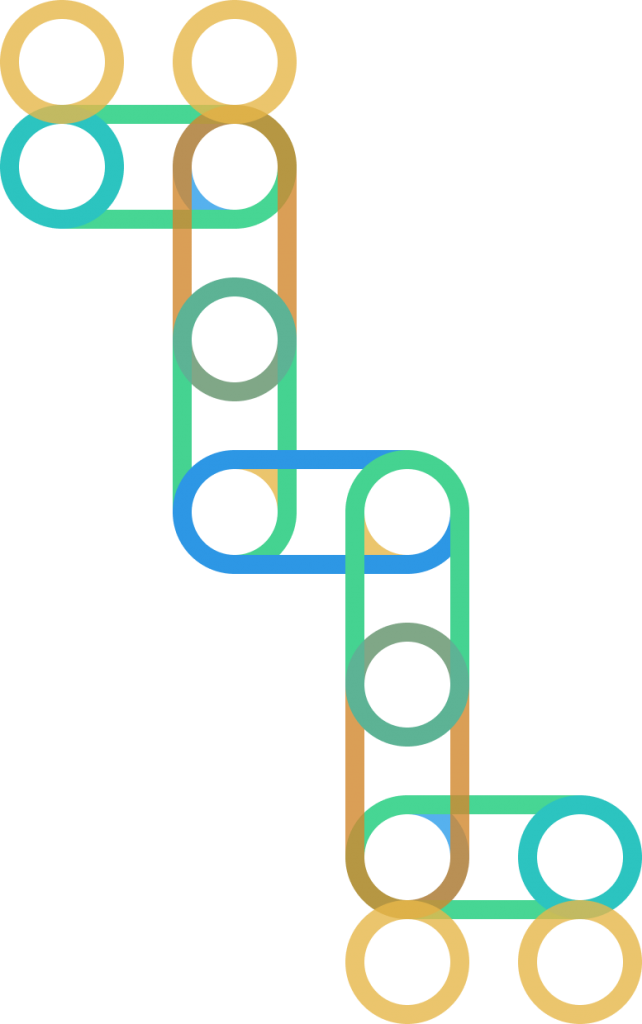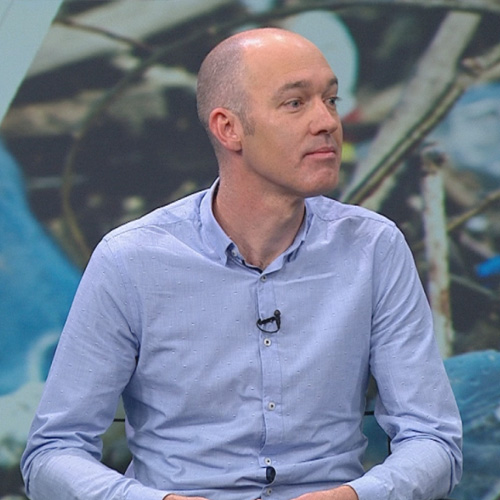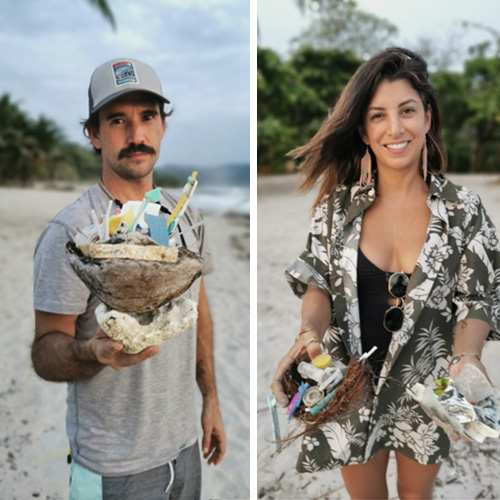
Moving from a “take-make-waste” economic model to a circular world of infinite abundance, a world free of waste is closer than we think.

Given the alarming rate at which plastic pollution is finding its way into our oceans and the wasteful way we are collectively throwing away $120bn of plastic packaging a year, it’s understandable why some find it difficult to envisage how the shift to a waste-free world will happen and when.
And yet, the people with most at stake in closing the loop on plastic production and our mismanagement of plastic waste, have little difficulty imagining a future – not too far from now in fact – where we look back on our current wasteful ways with an equal measure of disbelief.
In his inspirational book, The Waste Free World, Ron Gonen, the CEO of Closed Loop Partners, the New York-based private equity, growth and infrastructure fund accelerating the global shift to a circular economy, imagines a hypothetical day just five years in the future where living in a world free of waste is all too easy.
It looks something like this:
“You’re gently woken up by your five-year-old modular smartphone that works like new because it can continually be refurbished and upgraded. You feel refreshed waking up on sheets with the feel of a luxurious fabric—because they were manufactured from nutrient-rich algae. Stepping into the shower, you pump out body soap from your stylish, 100 percent recycled refillable shower soap dispenser. You get all your cleaning products as refillables now, paying only once for high-grade packaging when you first buy the product; any disposable bottles you use are either manufactured with recycled material and are 100 percent recyclable or are made of plant-based materials that are compostable. Heading to the kitchen, you fire up your gas range, powered entirely by your anaerobic digester that also heats all your water. You haven’t paid a gas bill since you installed the digester three years ago. You rarely have to take out the garbage, and disposal costs to your home and community are negligible. Grabbing the milk out of the fridge for your cereal, you notice that the color indicator on the front of the carton is verging from green to yellow, warning you the milk will be going bad in two days. With so many food companies affixing color-sensor warning patches to their food packaging, you can’t remember the last time you discarded food because you were unsure of its freshness. You pour some milk on corn flakes you brought home from the store in your reusable container. The flakes were made from corn grown through regenerative farming. A boom in regenerative farming around the world has already drawn down billions of tons of carbon from the atmosphere, reducing the effects of global warming. Your clothes are made from circular and nutrient-rich material. Your skin has never felt better. Hopping into your fully charged electric SUV, powered by your rooftop solar panels, which also provide all your household electricity, you head to your office in a Living Building, constructed from a carbon-sequestering cement replacement. You feel that every day, as more and more ingenious circular economy innovations come to market, you’re doing your part to combat the climate problem.”
He argues that this level of circularity is entirely plausible, writing, “we have the knowledge and the technology available to make all these products and services, to dramatically eliminate waste, and to build our homes and offices so that they renew the health of the environment. The question now is, how can we accelerate progress? How can we scale up proven solutions?”
Green Goods Driving Growth
The technologies already exist and Closed Loop Partners is invested in some simple materials solutions and some more technological innovations disrupting the recycling and plastic packaging industries.
The fund is investing capital raised from some of the world’s largest consumer goods companies – 3M, Coca-Cola, Colgate Palmolive, Johnson & Johnson Consumer Health, Keurig Dr. Pepper, PepsiCo, Procter & Gamble, Unilever and The Walmart Foundation, all of whom see a clear financial incentive to invest in a circular future, namely because it is where they are seeing unprecedented growth in demand for their products.
The clear financial incentive comes from the feedback they get from their sales teams. Sales of consumer goods marketed as environmentally friendly have increased at a much faster rate in recent years than those that aren’t, says Gonen, with a New York University study showing that between 2015 and 2019 they accounted for more than half of the total growth in sales.
Consumer goods companies that have been blamed for putting a brake on the transition to a world free of waste are now investing in companies building depolymerization plants, refill systems and AI-enhanced packaging solutions that are bringing about a profound transformation in the recycling and packaging of their products..
Biomimicry is at the heart of Gonen’s vision of a waste-free world, a future where, we once again regain a healthy relationship with nature and restore the fundamental understanding – lost in recent times – that we are, in fact, part of nature rather than, in some abstract sense, above, or beyond it in some way.
As Ellen MacArthur observed when she launched her foundation in 2010. “In nature, waste equals food. Waste does not exist in living systems.”
As books by systems thinkers like Paul Hawken, Joseph Bragdon, Herman Daly, Walter Stahel and E. F. Schumacher have started to hold greater sway in the boardrooms of the world’s largest corporations, banks and money managers, companies are waking up to the economic merit of putting natural capital on the balance sheet. Companies with processes that replenish our natural resources will be rewarded.
The acceleration towards a future of Abundance, outlined in the best-selling book of the same name written by XPRIZE founder, Peter Diamandis and his co-author Steven Kotler is irresistible given the convergence of information technology and finance attacking the problem of waste.
“Humanity is now entering a period of radical transformation in which technology has the potential to significantly raise the basic standards of living for every man, woman, and child on the planet. Within a generation, we will be able to provide goods and services, once reserved for the wealthy few, to any and all who need them. Or desire them. Abundance for all is actually within our grasp,” writes Diamandis.
Even while there are some that are alarmed by the slow speed of take up of the holy trinity of: Reduce, Reuse, Recycle, espoused by the Ellen Macarthur Foundation in its New Plastics Economy, according to Gonen, we already have one foot in a waste free future and its arrival is likely to happen sooner than some think.
While Plastics Europe president Dr Markus Steilemann, estimates that nearly 60% of global plastics production could be based on reuse and recycling by 2050, Gonen and Diamandis can see the speed with which technology is moving, enabling us to achieve our goals even sooner.
“One of the reason why things are accelerating is because there is this alignment of interests and that is building a sizable momentum so when you get consumers aligned with environmental organisations aligned with some substantial investors aligned with the fact that people are now moving into the C-suite are now more aligned with this way of thinking aligned with some of the natural disasters that we are seeing tied to climate change and people understanding that it’s going to be expensive if there is a fire in California every year, or if there’s going to be a flood in Texas every year, there are situations that happen in history where you have these alignments that happen due to different reasons and a movement all of a sudden accelerates because of that and that is the moment in time that we’re in right now,” says Gonen.
Future Fit Companies
For those looking to understand what the future looks like, it has already been with us for more than 50 years. To see it first-hand doesn’t require a time machine, just a trip to the Danish city of Kalundborg where you’ll find Kalundborg Symbiosis, a future fit industrial cluster built in 1972 by a group of 12 Danish and European companies that include insulin producer, Novo Nordisk with Orsted, Equinor, Biopro and Gyproc Saint-Gobain.
In Kalundbord, as in nature, the residue from one company becomes a resource for another, benefiting both the environment and the economy with resources reused in one harmonious loop that helps the companies save money and minimize waste.
A 2015 analysis of the industrial compound showed that since its inception, the park has reduced the greenhouse gas emissions the companies would have generated by 635,000 tons and collectively saved approximately $26m a year by eliminating waste and generating renewable energy on site.
The shift to this return to nature-based solutions, a waste free industrial revolution offers opportunities to the winners that will far outweigh those achieved in the first industrial revolution.
As Gonen writes, “While the Industrial Revolution generated enormous wealth as well as important innovations, its systems are often pollutive to the point of killing the consumer and land that it relies on for revenue and material. In the Circular Economy revolution, the returns to investors will be much greater because its practices are sustainable, aligned with the ecosystem of resources and customers on which companies and economies ultimately rely on for profits and growth.”
“The worst polluters will eventually fail in this new waste free world,” writes Gonen, “Either because their business model was never financially viable or because they were eventually forced, via legal action or government regulation, to pay the cost of cleaning up their waste and pollution.”
This is already playing itself out in the relative share prices of those investing in a waste free world and those clinging to the old economic model of take-make-waste.
Between 2010 and 2019, Unilever, one of the world’s largest consumer goods companies invested heavily to buy or develop its own eco-friendly brands, moved to remove plastic from its supply chain and increased transparency about its carbon footprint and that of its suppliers and marshalled a 290% increase in its share price as it did so.
During the same period, the world’s largest producer of plastic polymers and fossil fuels, ExxonMobil, saw no increase in its share price and last year saw it fall by 57%.
Investors have definitely moved from the 1980s philosophy of “greed is good” to a new industrial maxim, green is good.
Leading the way, Unilever is committed to reduce virgin plastic packaging by 50% by 2025, with a third coming from an absolute plastic reduction and help collect and process more plastic packaging than it sells by 2025. It will also ensure that 100% of plastic packaging is designed to be fully reusable, recyclable, or compostable and increase the use of postconsumer recycled plastic content in packaging to at least 25% in the same timeframe. In 2018, Unilever’s Sustainable Living Brands grew 69% faster than the rest of the business, up from 46% faster in 2017.
The stark contrast is clear for all to see and the success of Kalundborg is inspiring many variations on the theme in a host of different sectors and these are just the capital savings.
Unilever is not alone. Others in the industry have made similar commitments with Coca Cola creating its own vision of a world free of waste by 2030.
Spread across the consumer goods sectors, the World Economic Forum estimates that these changes could save businesses $700 billion, much of this in packaging, and analysis by McKinsey concludes that in the clothing industry could save the industry $500 billion a year.
On the other side of that equation are polymer and plastic producers who will need to adapt to deliver the transition to zero waste by increasing the participation of recycled content in the feedstocks used to create their products.
Gonen says that the overall economic benefit of “implementing entirely reasonable circular processes by 2030” could be as much as $4.5 trillion according to studies by management consultant Accenture.
An Opportunity That’s Too Big to Miss
In the plastic packaging and plastic recycling industry, Closed Loop Partners, is investing in materials solutions, refill technology and robotic recycling that are set to transform the industry.
At the heart of the food packaging business is its core mission to reduce food waste, something that Closed Loop Partners’ portfolio company Mori, does by removing the need for plastic and replacing it with a microscopic and edible coating that stops food from spoiling. Lettuce growers and strawberries are the prime contenders for early adoption.
The invisible, edible, and tasteless coating is made from silk molecules, extracted from silkworm cocoons, using just a mixture of salt and water. Testing with a number of foods has shown that the coating can extend freshness by two to three times, even without refrigeration. Apeel Sciences, which also produces a plant-based coating, has run trials for grocery giant Kroger with avocados, reportedly preventing rotting for as long as a month, apples and blueberries also stay good for a month.
New York State–based Ecovative Design has figured out a way to grow mycelium around biological waste products, such as wood chips and corn stalks, to make a foam packaging that’s as sturdy as plastic foam, is entirely nontoxic and highly water resistant, can be grown into any shape, and is 100 percent biodegradable, so it’s great for composting.
Other innovations that are driving a return to pre-WWII values of quality over quantity include product as a service, which is set to become an important pillar of the waste free world by reducing the amount of products discarded by consumers because they are “rented” by the consumer and returning the goods back to the producer is built into the business model.
With this approach, the manufacturer retains ownership, charging only for use, and therefore also retains product responsibility creating a greater incentive for building products that can be repaired and recovered. In the packaging industry, Closed Loop Partners, has invested in Chilean startup, Algramo, which is disrupting the take-make-waste approach to packaging.
Research by Mackenzie Wood indicates that the reuse model being explored by Algramo, could reduce demand for PET packaging by up to 25% as consumers in the developed world shift to carrying their own reusable containers, installed with radio frequency identification that enables them to buy the quantity of the product they want at a reduced price while reducing their environmental impact.
Algramo is able to distribute payments between themselves, the producer of the consumer goods and the “owner” or producer of the reusable packaging.
Focus on Food Waste
The ability to benefit from these types of new technologies will flow fastest to those companies that are open to new conversations and are being truly open about their current failings in their bid to transition to a circular, carbon neutral future, says Gonen.
Those companies that are able to set forth a vision for a natural capitalism system; a capitalist system that not only preserves but rebuilds natural capital will profit most in the transition to zero waste as they will dominate an industry that is fit for a very long future.
As Gonen says, “for established companies, it requires focusing initially on particular products or product lines, and most often begins with the simplest processes—switching to renewable energy, and replacing virgin materials with recyclables or ecologically healthier ones, like sustainably grown wood and cotton. Creating new product designs with modular components for easy repair or recycling and developing reverse supply chains to take back and recirculate their products.”
Many packaging companies originally started out on their journey with a clear mission and it wasn’t to sell plastic. Most started with a clear intention to attack one of the most pressing problems of the time, that of food waste, and yet in the world’s largest per capita consumer of food packaging, the problem of food waste remains.
In the US, an estimated 40 percent of food produced is still being wasted every year.
The global estimate is 30 to 40 percent and consumer reports estimates that the average American throws out a pound of food, or 1,250 calories, a day, ten times more food than the average person in Southeast Asia and sub-Saharan Africa.
Food waste constitutes the largest portion of the waste stream sent to landfills, at just over 20 percent. Paul Hawken’s Project Drawdown ranked reducing food waste as the third most effective means of reducing greenhouse gases in the atmosphere.
In the circular industrial revolution, packaging companies that are laser-focused on this problem will succeed as they will be helping to solve arguably the principal problem of waste affecting their industry and have a bigger systemic impact on the food industry it serves.
“It turns out,” the authors of Natural Capitalism asserted, “that changing industrial processes so that they actually replenish and magnify stock of natural capital can prove especially profitable.”
If you like this content and would like to help close the loop on plastic waste then join the AdaPETation Network by clicking on the button below.
Share it
Useful Links
THE HISTORY OF PLASTIC
Throughout the history of plastic, PET has been crucial in keeping food fresh with lightweight and durable packaging solutions that have helped reduce food waste for almost a century. Learn all about the invention of plastic and the important role it has played feeding people and saving the lives of humans and elephants in the adaPETation® timeline of the history of plastic.





